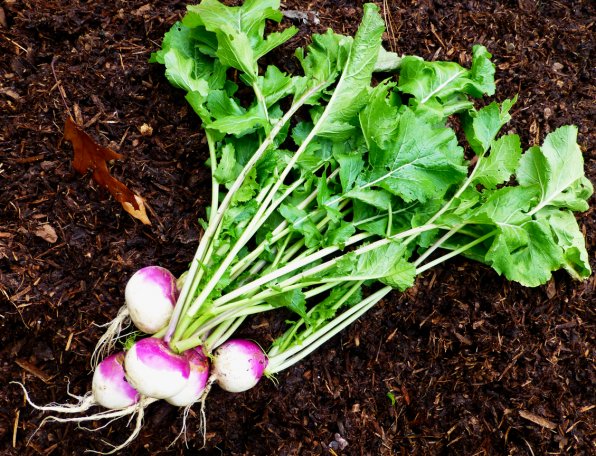Clear your palate with a swig of fresh apple cider, and open your mind with a few deep breaths. Banish from your memory any remnants of the old, bitter turnips of your childhood. It’s time to get to know the underdog of fall vegetables: the fresh turnip.
You may associate turnips most closely with potatoes, the comfortable old standby of the underground veggies world. Like all root vegetables, turnips are satisfying to eat, being loaded with starch, sugars, vitamins and minerals. Turnip, however, are more closely related to radishes than potatoes; both are members of the immense mustard family, the Brassicaceae, making the oft-shunned turnip a close cousin to more welcome, familiar favorites like broccoli and cabbage. The family also goes by the name “Cruciferae,” meaning “cross-bearing,” because each of its more than 3,500 species features flowers showing four petals – you guessed it, in the shape of a cross.
The turnip, the humble root of our grandmothers’ gardens, deserves some attention. I encourage you to find a few fresh turnips at a local farm, farmers market or, if you’re lucky, at the grocery store. Look for smallish white roots with a lovely purple edge at the upper ends. If you can find them with greens attached, all the better. The entire turnip plant is edible. Don’t buy soft, shriveled or otherwise old-looking turnips. Young and sweet, with a bit of zip, is the flavor we’re after.
Think of the family of cruciferous vegetables as an extended family of uber-healthy cousins. Each and every one offers high levels of vitamin C, soluble fiber and plenty of cancer-fighting phytochemicals. It’s a proud and powerful family, continually expanding its territory thanks to the efforts of modern plant breeding. Turnips, members of the Brassica genus, are often relegated to an occasional stew or soup and not much more. I urge you to find a few and give them another try.
Small is good and fresh is best. Check out the winter farmers markets that are starting up now in towns all around Concord and be on the lookout for small, fresh turnips with dark, healthy greens intact. The fresher the turnips, the sweeter the flesh. Many turnip recipes call for a pinch of sugar; you might not find this necessary if you’ve been lucky enough to find them fresh and locally grown. For the New Hampshire Department of Agriculture’s full list of winter farmers markets, visit agriculture.nh.gov.
The turnips themselves will keep for a few weeks in the refrigerator so, when you get home, cut off the greens and store the roots. You’ll want to wash the greens at least three times (those ruffled leaves tend to carry a fair amount of grit in their nooks and crannies) before chopping them for your evening meal. Turnip greens are delicious braised or stir-fried with crushed red pepper and sliced onions. Dice a turnip roots into the stir fry, too, for a little texture contrast. Meat-eaters will find that turnip greens pair beautifully with chopped bacon or ham, in the southern style. Either way, a swirl of dijon mustard into the pan adds a fun twist.
When you’re ready to cook your turnips, unleash your creativity. Of course, turnips can be roasted with your other fall vegetables, but why stop there? They’re delicious with pot roast and in hearty fall vegetable soups – any place you might use other root vegetables. Turnips have a higher water content than the others, so they take on flavors well. The flavors of marjoram, parsley and thyme all compliment turnips nicely. They’re delicious grilled: marinate thick slices in a dressing of olive oil, lemon juice, coarsely ground black pepper and minced garlic. Marinated turnip slices will take about three minutes per side to crisp up on a hot grill.
Fresh turnips are yummy raw, too. Try grated turnips as an alternative to cabbage in your favorite cole slaw recipe, or simply grate a bit onto a winter salad. You might come across fall salad turnips, too. They’re all white and look like large radishes. Use them raw and be sure to eat the greens!
For a grand autumn dinner, lay down a bed of fluffy, mashed turnips under a roasted chicken. Puree them with butter and sour cream and get creative with your fresh herbs. The chicken juices will flavor the turnips even more. At about one third the calories of mashed potatoes, mashed turnips are a healthy alternative, loaded with fiber, vitamins and minerals. If you’re not quite there yet, go for a fifty-fifty mixture of turnips and potatoes. They’ll grow on you!
Eleanor Baron lives, gardens, cooks, and writes in Concord, and stalks area farmers markets for fresh, in-season produce. Visit her blog at nourishingwords.net for more ideas and inspiration on incorporating healthy habits into your life.









